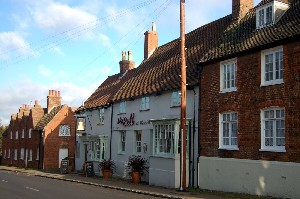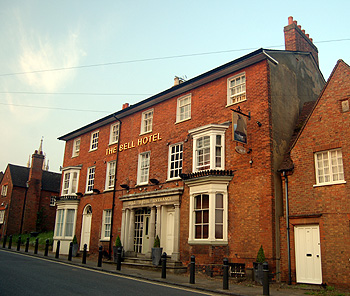The Bell Public House and Hotel Woburn
![The Bell public house in 1961 [Z50/135/8]](/CommunityHistories/Woburn/WoburnImages/Bell 1961 Z50-135-8_350x274.JPG)
The Bell public house in 1961 [ref: Z50/135/8]
The Bell Public House: 21-22 Bedford Street, Woburn and Hotel: 34 and 35 Bedford Street, Woburn
The Bell was described by the former Ministry of Buildings and Public Works when they listed the building in 1961, as dating from the 17th and 18th centuries. They also noted that it was formerly two properties. The building is finished in colourwashed roughcast render. Number 21 has brick on the ground floor with timber framing above whereas Number 22 is completely brick. The property has clay tiled roofs and comprises two storeys.
The first mention of The Bell in the records held by Bedfordshire Archives comes in 1739 [ref: GK89/1] when it was conveyed by Edward Wallis of Westminster to Catherine Shefford of Woburn, widow, for £160 where it is described as a "messuage or tenement, barn, stable and orchard adjoining called The Bell, Woburn, now in occupation of Thomas Langford".
Catherine, in her will of 1747 (proved 1752) [ref: GK89/2] devised The Bell to her granddaughters Ann and Catherine Shefford. Ann later married and her son Rev. Henry Land of Colebrooke [Devon] sold The Bell to Richard Ambrose Reddall, the Woburn solicitor in 1796 [ref: GK89/3]. Reddall left The Bell, in his will of 1841, to his cousin John Land, an officer in the Royal Marines [ref: GK89/5].
In 1871 the Bell featured in a case of passing counterfeit money [ref: QSR1871/2/5/7]. Hannah, the wife of James Healey of Woburn, the innkeeper was asked to provide lodgings on 22nd March that year to Thomas Rose. She said she could not accommodate him. He left and returned in about three-quarters of an hour later with a man and woman. They pressed her to take them all in. She refused at first but later agreed.
They all slept in a double bedded room. The next morning they got up about 8 a.m. and remained in the house for some time. Rose went first and left the man and woman behind. He returned between 11 and 12 o'clock and had a pint of beer. Rose gave her what she supposed to be a sovereign, she gave him change and he left the house. She put the sovereign in a drawer with three half-sovereigns and no other money. Between 1 and 2 p.m. she examined the sovereign and found it was very light. She sent her son with it after her husband who was in the town and to look for Rose. She saw nothing of Rose’s wife.
James Healey said in evidence that his son came with a sovereign which he found was a bad one and very light. He went to look for Rose and saw him at the Shoulder of Mutton Inn at Woburn. He showed Rose the sovereign. Rose said his master gave it to him that morning and he would go and make it right with his [Healey’s] wife. They went to his house together. He went up the steps and Rose ran away. He ran after Rose calling “stop thief”. He pursued him down the Crawley road. Rose left the road and went over the fields in the direction of Aspley Woods. Healey came back and went down the Woburn Sands road [Newport Road] thinking to intercept him. A few minutes later he saw Rose in a field with several other men. They brought Rose to him and he was placed in a cart. He met P. C. Whinnett and gave Rose into his custody.
Alfred Baker of Woburn, an engineer stated in evidence that about 2 p.m. he went in pursuit of Rose. He and others crossed two fields from the Crawley road and saw a man running by the side of a hedge. The man turned right and made towards Mr. Brown’s barns in the direction of Aspley Woods. He found Rose lying in a ditch close to a rick. He believed Rose came from under the rick - he staggered about and fell into the water. He saw Rose taken out of the ditch and placed in a cart. James Healey got up into the cart with him and took him away.
William Whinnett of Woburn, the police constable, stated that about 2 p.m. on Thursday he received Rose from James Healey, who charged him with passing a bad sovereign. Rose said he knew nothing about it and that his master John Sherby gave it to him that morning to get himself [Rose] and his wife breakfast. He later heard Rose say to his superintendent that he didn’t find any more [counterfeit money] about him and can’t think how he came to be such a fool as to run away.
Charles Turner of Woburn, a silversmith, stated that the coin produced was a bad one. It appeared to be an alloy of copper and brass or zinc washed with gold. On close examination he believed the greater part to be zinc.
Thomas Rose stated in his own defence that he brought two horses from Northampton to Woburn Fair. "He" [not named] lent him 6d. on the road and went on in front. Rose met "him" coming into the town with the horses, gave him a sack to get some corn and told him to get him lodgings at the same time. He went to the Bell, but they could not take him. As he was coming back with the corn he met "him" and two Bedford men. They all went to the Bell and "he" paid for 2 quarts of beer. They went out and he asked "him" for 6d. more which he gave and told Rose to go to bed and get up at 8 a.m. "He" called him in the morning. He got some corn for "him" and asked for some money to get breakfast. "He" said he would come down but never did. Rose waited for an hour then went to "him" in the Fair. "He" asked Rose to run a pony up the street. He did so. About 12 p.m. he asked "him" for some money and was given the sovereign. "He" told Rose to go and change it and take 2s. out of it. He did so and bought the remainder of the change to him. "He" said he would give 3s. and afterwards did so, saying it was the 6s. for his two days' work. He changed the sovereign at Mrs Healey’s. He did not know it was a bad one. Rose was convicted of uttering counterfeit money and received nine months' hard labour in Bedford gaol [ref: QGV12/2].
John Land in his will of 1876, devised The Bell to his nephew William John Land of Cobham [Surrey] [ref: GK89/6] who sold The Bell to George Higgins, the Bedford brewer in 1879 [ref: GK89/4]. Higgins and Son sold out to Biggleswade brewer Wells and Winch in 1931. This firm merged with Suffolk brewers Greene King in 1961, adopting the Greene King name in 1963. Greene King still owns the public house and hotel at the time of writing [2006].
In 1927 the public house was valued for rates under the 1925 Rating and Valuation Act. At that time the rent was £11 per annum and had been since 1910. The valuer noted that the building as an "Old fashioned house up 6 steps". It consisted of a bar parlour ("good"), tap room ("good"), bar ("small 4 pulls"), larder and kitchen downstairs, with a cellar beneath; four bedrooms on the first floor; two attics on the second floor; coachhouse and stable for four horses outside with loft over, public urinal, barn and ladies lavatory outside. The outside buildings are described as "good buildings but practically unused". Trade consisted of one and a half barrels of beer per week, eight bottles of spirits per month and one or two dozen beer bottles per week.

The Bell public house in March 2007
Today [2012] The Bell includes accommodation across the road from the public house, at 34 and 35 Bedford Street. The valuer carrying out the assessment under the 1925 Rating and Valuation Act and visiting 34 and 35 Bedford Street [ref: DV1/C137/24-25] found that, like much of Woburn, they were owned by the Duke of Bedford’s London and Devon Estates Company.
Number 34 was occupied by William Wood whose rent was “in wages” so he evidently worked for the duke. His accommodation comprised two living rooms, a kitchen and a parlour on the ground floor, four bedrooms (“no bath”) on the first floor and five bedrooms on the second floor. There was also a cellar. A “very good” washhouse and barn lay outside. The valuer remarked “Bay up and down”
Number 35 was in the occupation of F. and W. Mitchell and, once again, their rent was “in wages”. They had two living rooms, a kitchen, a scullery and a cellar with three bedrooms and a bathroom on the first floor and four bedrooms on the second floor. A washhouse and barn (“very good”) stood outside.
The two properties were listed by English Heritage in March 1987 and were dated to the early 19th century. They are built of red brick with slate roofs and comprise three storeys. They have a double pile plan, that is, a block beneath two parallel roofs.

34 and 35 Bedford Street, May 2012
List of Licensees: note that this is not a complete list. Italics indicate licensees whose beginning and/or end dates are not known:
1739: Thomas Langford;
1746: Francis Butler;
1746: James Butler;
1785: John Piddington;
1796: Thomas Evans;
after 1796: Francis Moor;
1802-1818: Thomas Cook;
1820: John Chamberlain;
1823: William Chamberlain;
1839: Frances Snooks;
1850: Jesse Lewis;
1853: William Rosson;
1864-1871: James Healey;
1893-1895: Mrs.Emma Weston;
1895-1910: William Westson;
1910-1944: Howard Ross;
1944-1947: Edward Robert Montague Thornett;
1947: William Henry Hall;
1951: Selby Rutherford;
1956: Thomas Levi Coleman;
1970: Gavin Rex Gendall;
1980-1982: Derek Arthur Younghusband;
1982-1984: Trevor Anthony Deacon;
1984-1985: Brice O’Dell;
1985-1996: Timothy John Chilton;
1996: Timothy John Chilton and John Murray Seaton-Reid;
1996: Richard Heathorn.
List of sources at Bedfordshire Archives:
- GK89/1: Conveyance: 1739;
- GK89/2: Devised in will: 1747 (proved 1752);
- R3/169: Duke of Bedford's agent lodging at the inn: 1760;
- GK89/3: Half of Bell conveyed: 1796;
- P118/28/2: Parochial assessment book: 1802-1833;
- R1/78: Thomas Evans' map accompanying R2/69: 1821;
- R2/69: Survey of Woburn by Thomas Evans for the Duke of Bedford: 1822
- R6/29/2/8 & GK89/5: Devised in will of Richard Ambrose Reddall: 6 Jul 1841
- QSR1851/1/5/26a-b: Case involving a stolen umbrella: 1850
- R6/29/2/10: Lease - Ann Reddall to George Higgins for £42 p.a, 1862
- R6/29/2/11: Succession duty on the death of Ann Reddall: 1863;
- QSR1871/2/5/7: Counterfeit money passed at The Bell: 1871;
- GK89/6: Devised: 1876;
- GK89/4: Conveyed: 1879;
- GK89/9: Schedule of deeds: 1739-1879;
- GK4/2: Conveyed: 1884;
- ST/U4/6-7: Valuation notebooks: 1891;
- ST/U4/21: Valuation notebook: 1896-1897;
- GK4/4: Agreement to raise shares in Higgins & Sons Limited:1902
- Z1169/6/6: File on repairs and redecorations: 1922
- GK4/6: Schedule of deeds of Higgins & Sons Limited: 1927
- GK4/7: Agreement for lease of water and sewerage rights: 1927
- GK4/8 and GK297/1: Conveyed: 1931
- BTNegOB50/1: Negative: c.1931
- Z1105/1: Liquor Licence Traders Survey Form: 1956
- Z53/135/8: Photograph: 1961
- PCWoburn18/2/9: First floor plan and photograph of front: 1992
- PCWoburn30/28: Transfer of licence: 1996;
- PCWoburn30/31: Transfer of licence from: 1996